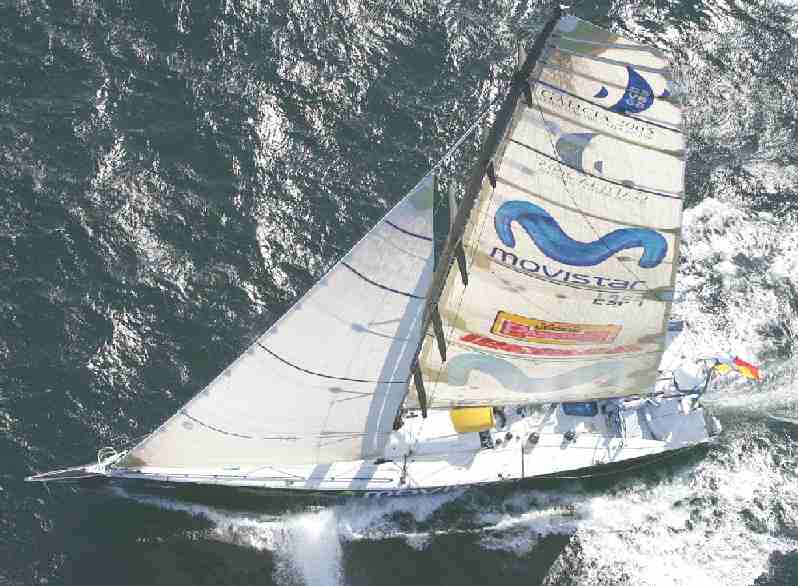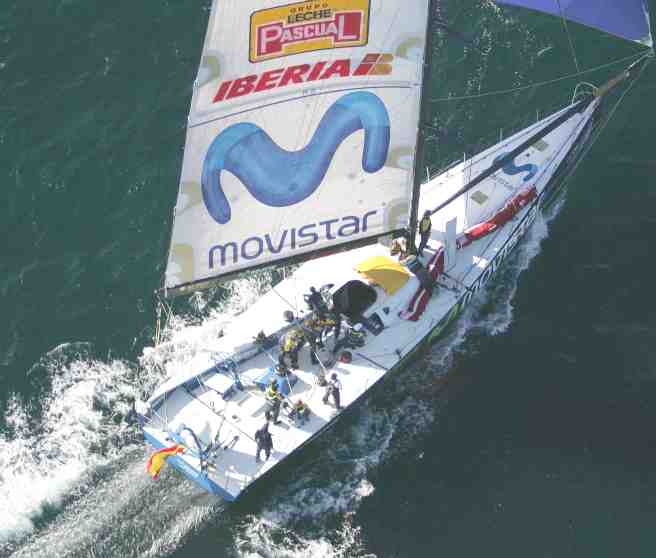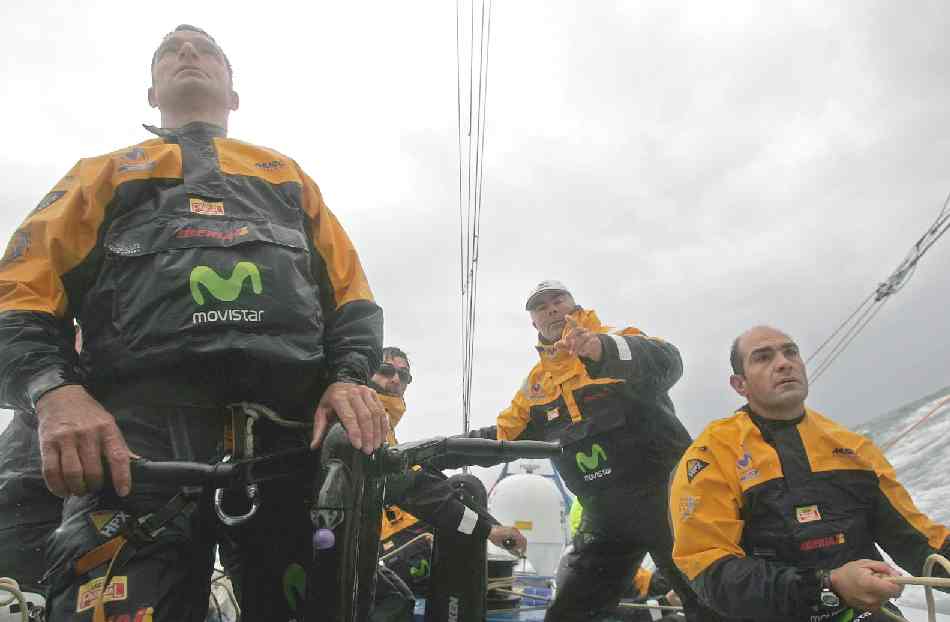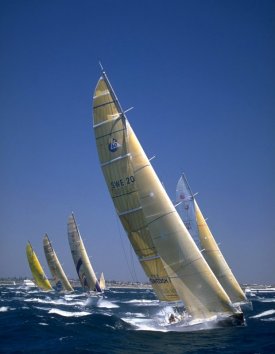|
THE VOLVO OCEAN RACE 2005-2006 - MELBOURNE |
|||||||||||||||||||||||||||||||||||||||||||||||||||||||||||||||||||||||||||||||||||||||||||||||||||||||||||||||||||||||||||||||||||||||||||||||||||||||||||
|
HOME BIOLOGY CREW GEOGRAPHY HISTORY INDEX MUSIC THE BOAT SOLAR CELLS SPONSORS |
|||||||||||||||||||||||||||||||||||||||||||||||||||||||||||||||||||||||||||||||||||||||||||||||||||||||||||||||||||||||||||||||||||||||||||||||||||||||||||
|
Hydraulic
failure recurred 24 hours after repair, after rounding the
second scoring gate at Eclipse Island "MOVISTAR"
STILL TROUBLED BY HYDRAULIC FAILURE; HANGS ON TO THIRD PLACE Melbourne
(Australia), January 18th, 2006 The second leg of the Round the World race is proving to be tough, hard and stressful; the struggle for first place is even harder as a result of mechanical failures. “movistar” had apparently solved her hydraulic failure, but it has reappeared again in the last hours. “Back to where we were on movistar. The replaced O-ring in the port hydraulic ram has spat the dummy. Consequence, the keel is back to a max of 20 degree, this way not much force on the cylinders and less loss of hydraulic fluid. We can go of course to a single ram, but after what happened last evening to the Pirates, want to use that as the last option” – said “movistar” skipper Bouwe Bekking.
There
are still 800 miles to go before the finish line, strong winds
and the boats will have to cross Bass Strait, where sailing is
complicated, dangerous and very hard on the equipment when the
weather is rough. “Who gives me a guarantee that our rod will not snap as well?” – asks
the Spanish boat skipper. “These
rods were replaced in Cape Town, after recommendation after what
happened to Ericsson in leg 1, but I guess they must have mixed
up some material numbers, and made the rods out of recycled
coca-cola cans” The crew is in complete disbelief about what is going on: “It
is hard to believe, you lay your trust in a worldwide well
respected hydraulic company and this happens. This was supposed
to be a yacht race and not a survivor race”. The
main priority now is to keep the boat safe and to maintain the
third place. “Although
it still has the first principles of yacht racing intact. You
have to finish before you get to score points, so we are in
fully in that mode”.
When they reach Melbourne, drastic measures will be taken with respect to the pivoting keel hydraulic system. “Comes
of course the question: how did you manage to sail 20.000 miles
before, without having real problems with the hydraulics?
Answer: they were nearly double the weight, and working with a
less pressurized system, and I changed them for
"performance" gain to be made”. “In
Melbourne we will rip these ones out, and send them back to the
manufacturer and put our stainless steel ones back in movistar.
It is easy to calculate how many hours the boat will be slower,
when sailing them virtual around the world with the heavier
rams, but at least you can sail the boat full throttle and
...........can sleep a little better when off-watch”. “It
looks tricky ahead” Regarding the lead of the two Dutch boats, 150 and 100 miles respectively, Bekking put himself in their shoes: “I
know the leaders probably think: not again. But light air will
suit us well, as we don't need to swing the keel to gain
stability”. There is growing frustration on board about the unsuccessful chase of the Dutch boats, but the history of this leg and the very history of the Round the World race make the crew confident again.
“Of
course everybody is down a bit, but what I said to Mike Joubert
today has hit like a hammer. I asked him in what position they
were after leg 2 with Assa Abloy in the last race (they finished
second). Slowly a smile appeared on his face, changing into a
big grin. There is still a lot of racing to be done”. Pedro Campos, general manager of the Spanish team, said “once again in this leg, we are holding our breaths and keeping our fingers crossed, hoping to reach Melbourne in one piece. We are suffering so much on shore, that I can easily imagine what they are going through on board. But these are great professionals and we are fully confident in their experience and good judgment” “I just found out about Brasil’s serious problem, and wish to send our support and encouragement to our Brazilian friends; we hope they can solve the problem and make it on time”. “Finally,
I want to thank everybody in Spain and especially in Galicia,
for their continued support. It would be impossible to mention
every one, so I will just refer to three institutions which
represent us all: First of all, the Casa Real, constantly in
touch with our team, expressing their support; the Spanish
Government, which is also supporting us at all times through the
State Secretariat for Sports; and the Galician Government, which
through the Presidency, is closely following daily developments
on the “movistar”, congratulating us for our successes and
supporting us in difficult times”.
“To
all of them and through them to everyone in Spain, our heartfelt
thanks”.
Temporary
standings (16 days
and 5,338 miles into the race): 1º
AMRO One (Netherlands) 762 miles from the finish 2º
ABN AMRO Two (Netherlands), 46 miles behind the leader 3º
movistar (Spain), 155 miles behind 4º
Pirates of the Caribbean (USA), 472 miles behind 5º
ING Real Estate Brunel (Australia), 899 miles behind 6º
Brasil 1 (Brazil), 1,972 miles behind 7º Ericsson (Sweden), retired
Movistar have moved back up to third place 12 January 2006
Overnight, Paul CAYARD’s (USA) Pirates of the Caribbean was overtaken by movistar when the crew noticed cracks in the area of its keel support structure. Water was coming into the boat from those cracks and still is. The rate of water flow is manageable at this time.
Thursday, 12 January 2006 - Ana Garcia:
Movistar in third place: - Picture © María MUIÑA 12 January 2006
Volvo Ocean Race: Designers not concerned about cracks in Black Pearl’s keel - Thursday, 12 January 2006
Volvo Ocean Race organisers say that Paul Cayard’s
Pirates of the Caribbean’s keel problem is not serious
and the boat should be back up to speed by the next
position report.
'Sail was immediately reduced. Photos and video of the cracks were recorded and sent to the designer of the boat. 'Several hours were spent discussing this issue with the designers of the boat. A certain level of comfort was achieved and we proceeded, with reduced sail, east at twelve knots through the night.
'This morning we have reviewed the drawings of how this area was designed. It is not clear to us if this is structural damage or superficial. The fact that water is coming into the boat is not reassuring. We have a made a new video and photos in the daylight, and sent them off to the designers. 'We have run tests with 0, 20 and 40 degrees of cant while inspecting the area. 40 degrees is definitely alarming. The cracks open and close as the loads change and the water flow is more and less accordingly. 20 degrees seems tolerable.
'It is not clear to us, and probably will never be clear to us or anyone, how serious this damage is until we reach land. We simply can't properly inspect the area out here. 'On the weather side, the best winds to help us make the progress toward Australia are during the next 30 hours. We currently have winds from the northwest. Eventually, we will fall 'of the back' of this system and be hit with less favourable winds from southeast. There is danger in being out here for long time.
'Therefore, considering all of the above, I have decided to run the boat up to 80% of full speed at this time, with a maximum of 20 degree of cant, to make as much progress as reasonably possible in these conditions. 'Naturally we are taking all precautions necessary for any eventuality. 'In general, all is well and stable onboard the Black Pearl.'
Movistar in third place: - Picture © María MUIÑA 12 January 2006
Looking Forward To The Next Scoring Gate
As the fleet passed the halfway point in leg two of the Volvo Ocean Race, complex weather continues to challenge the fleet. However, Chris BEDFORD, race meteorologist, says, that given the expected conditions, the leaders should be nearing the second scoring gate of Eclipse Island off Australia, by Sunday.
As the fleet peels off towards the higher latitudes once more, concerns about ice remain on everyone’s minds. Updated ice information was given to the fleet on Tuesday, just before they passed the final ice gate and started to head further south.
It is likely that the fleet will want to remain in the stronger winds as long as possible incurring some extra distance. The turn northeast towards Eclipse Island will be critical and the navigators will need to identify the optimum time to make the turn. A series of high pressure centres with very light and shifty winds will move towards the Australian Bight and a ridge of high pressure with accompanying light winds will move between the fleet and the scoring gate.
Position Report At 1000 Hours UTC, 12 January 2006
Overall Leaderboard
CAPE
TOWN: Brasil 1 has rejoined the Volvo ocean yacht race after
undergoing repairs in the coastal city of Port Elizabeth.
The boat was forced back to shore just 24 hours into the 6100 nautical mile second leg between Cape Town and Melbourne because of structural damage. "The team is in very good spirits now and getting back into racing mode," skipper Torben Grael said. "It feels very good to be back sailing and the boat is behaving very well with the repair. The reinforcement that has been done should stop it happening again and we expect to be in Melbourne before the end of the month."
Ericsson Racing were also forced to turn around on the first day of the leg after sustaining keel damage and have decided to ship the boat to Melbourne ready for the third leg. Mike Sanderson's ABN AMRO ONE continue to lead the fleet, despite conceding ground after plunging south in an effort to find more wind. They hold a 288-mile lead over ABN AMRO TWO with Paul Cayard's Pirates of the Caribbean third.
January 9, 2006
OSLO, Norway – The Dutch yacht ABN AMRO ONE was increasing its lead on a fleet battling unstable winds, fog and cold drizzle a week into the grueling southern ocean leg of the Volvo Ocean Race.
The U.S. entry Pirates of the Caribbean was second Monday en route from South Africa to Australia, followed by the second Dutch boat, ABN AMRO TWO, Movistar of Spain and ING Real Estate Brunel of Australia.
The wet, cold, exhausted and constantly hungry crews are always on the lookout for icebergs and whales, which could sink them. This vigil often is in the dark, at speeds of up to 45 mph and hundreds of miles from help.
Waves in the southern ocean reach 50 to 60 feet, launching the 70-foot boats, which then crash back onto the water. "The conditions here are quite quickly getting worse," ABN AMRO ONE skipper Mike Sanderson said by e-mail from the boat Monday. "We are working hard to try and keep this missile under control. We have done some jumps at the end of some of these waves that would make Evil Knievel proud."
The No. 1 Dutch boat's lead of 301 miles put it in a belt of stronger winds than the rest of the fleet. The second leg of the seven-month, 7,020-mile around-the-world race started from Cape Town, South Africa, on Jan. 2, and ends later this month in Melbourne, Australia. The race ends in June in Gothenburg, Sweden, after stops in Australia, New Zealand, Brazil, the United States, Britain and the Netherlands.
ABOUT THE VOLVO OCEAN RACE
The Volvo Ocean Race is the ultimate mix of world class sporting competition and on the edge adventure. It takes 8 months, covers 31,000 nautical miles of treacherous seas over 9 legs, in the process visiting 10 ports around the world.
The teams comprise professional sportsmen and women at the top of their game. The race requires their utmost skill, physical endurance and competitive spirit as they race from continent to continent in an easterly direction around the world.
Round The World Yacht Race 2005 - 2006:
The Volvo Ocean Race is a marathon event. For nine months, world-class racers battle each other around the globe over some 32,700 miles (52,600 kilometers). Participants spend weeks at a time driving their boats to the limit 24 hours a day. They sacrifice sleep, privacy, fresh food, and other comforts to win each leg. But what happens when they reach the next port of call?
The race doesn't stop-it just shifts gears. Weary sailors get a chance to rest and prepare for the next leg, while the shore crew swings into action. After weeks of demanding action, and a spartan existence at sea, the first things these exhausted sailors crave are basic human needs. The event will start on November 5, 2005 with an inport race in Sanxenxo, Galicia, Spain.
The race track will continue to follow the traditional route of the old clipper ships, sailing around the world with the prevailing winds. An exciting new feature introduced for this event is a number of scoring gates and pit stops around the world, where the fleet will be able to score points, which will count towards the final score.
|
|||||||||||||||||||||||||||||||||||||||||||||||||||||||||||||||||||||||||||||||||||||||||||||||||||||||||||||||||||||||||||||||||||||||||||||||||||||||||||
|



